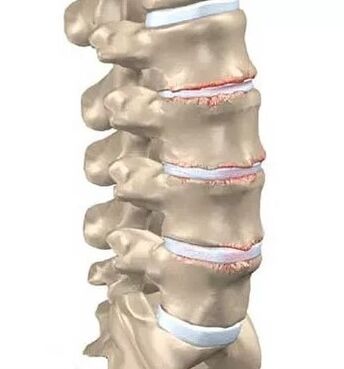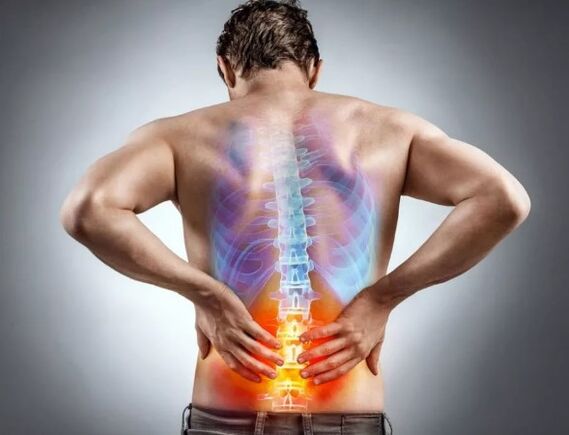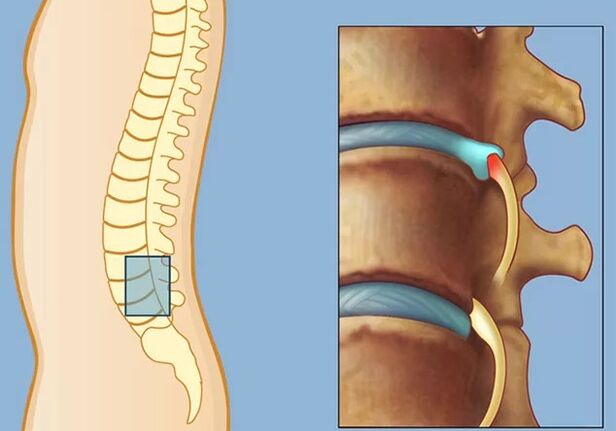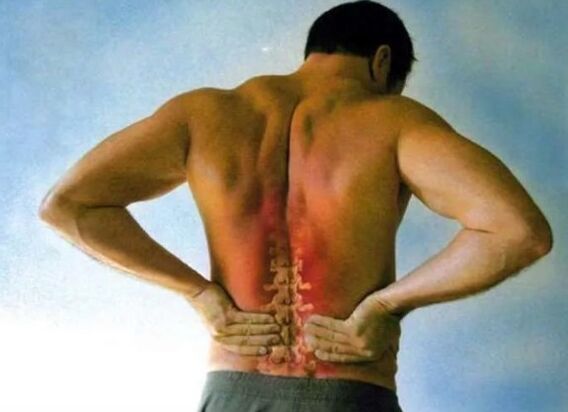The osteochondrosis of the lumbar column is a disease that is a special form of damage to the spine. Patients with such a disease complain of rapid fatigue, back pain, legs, which causes limiting motor activity. With osteochondrosis, there is a deformation of intervertebral discs, there is a decrease in its height, dystrophy and coracoid the growth of vertebrae. When diagnosing the radiography, the dischanes are clearly visible.

The deformation of cartilaginous tissue during the development of osteochondrosis is a complex process, which includes biochemical and vascular changes. First, the fibrous ring is destroyed, as a result of which pulp is introduced. As a result, the fibrous ring is torn and the hernia of the disc is formed. In this case, the lower background and lower lover segment is subject to the highest load. The hernia of the disk, pressing the spinal cord or its roots, becomes the cause of back pain, which responds in the leg.
The most powerful sciatic nerve of the human body is formed by the sacred roots of the spinal cord. They are, as well as the lower lover, are irritated with osteochondrosis. From the Latin name of the sciatic nerve, in relation to this, the second name of the disease was formed: Ishias.
Due to the violation of the cartilage fabric structure, intervertebral discs, which are special cartilage structures, can no longer fulfill all their functions. This leads to the loss of flexibility and mobility of the spine. The processes, which in the initial stages of the disease affect only intervertebral discs, gradually apply to the vertebrae themselves.
The discogenic radicolite, which is considered one of the most common symptoms of osteochondrosis, is found in almost every fifth person over 30 years in the world. At risk, working age are often at risk. Osteochondrosis deprives the ability to participate in active activity and often cause disability.
Lumbar osteochondrosic symptoms
The main symptoms of lumbar osteochondrosis are severe back pain. However, in addition to this sign, there are several others. Therefore, patients suffering from this disease get tired quickly, complain about headaches, fatigue and irritability. The discomfort at the back does not allow you to choose a convenient position to sleep, so the body cannot relax and recover completely after the end of the day. Loss of strength forces the patient to minimize physical activity and avoid pain. This leads to the fact that over time it does not become able to perform simple actions, for example, to provide their own domestic needs.

Problems in the work of the genitourinary system can also be one of the symptoms of lumbar osteochondrosis. They appear in the form of pain in the renal area. In patients with osteochondrosis, urination is interrupted, the unexpected occurrence of discomfort without cause is possible. This leads to the instability of the vertebrae, which due to the deformation are not set by intervertebral discs. The load in the column causes the displacement of the lumbar department of the sacrum when the severity of the force is exposed to it. Such a process causes damage to internal organs, problems in their work. In women, ovaries, appendices and the uterus suffers more frequently, and power are disturbed in men.
Osteochondrosis is characterized by an increase in leg sensitivity, including stops, hips and lower legs. They are cramps that can lead to a total loss of the pulse. The patient's skin with leg osteochondrosis is very dry, peeled and covered with chicken skin in the discomfort area. During the episodes of pain, sweating is altered.
All symptoms of osteochondrosis can be classified into the following groups:
Syndrome
The thinning of the intervertebral discs leads to the loss of stability vertebrae. Having returned mobile, they begin to be annoying and tight blood vessels and nerve roots with acute movements and a strong physical effort. This process minimizes pain in the lumbar region, but they resume with a renewed vigor where the nerve is compressed. The pain is acute and is drilling. The greatest discomfort is expressed in the lower part of the leg, thigh, foot and buttock. Unpleasant sensations make the patient change the march, leaning on the opposite side of the nerve.
When nerve roots are irritated for a long time, their inflammation, swelling, venous stagnation and intoxication occur. Pain applies to muscles, ligaments. It is more acute in moments of physical activity, especially if it is carried out without hot, immediately after sleep or a state of rest. The pain is often accompanied by greater sweating, which replaces the sensation of chills.
The manifestations of the root syndrome also include tingling, numbness and loss of sensitivity. Muscles lose their tone, so patients cannot bear long -term physical activity, for example, lowering and lifting the stairs, they quickly get tired. The functions of the pelvis are interrupted in especially severe cases. In this case, even the appearance of paralysis and paresis is possible.
Ischemic syndrome
The nearby nerve roots are blood vessels, which are compressed during deformation. In the early stages of development of osteochondrosis, arteries are squeezed periodically, but then a spasm acquires a constant character. In this case, there is a "scoring hill", the patient must often stop and rest with a long way.
Closing blood vessels leads to the fact that pelvic organs do not receive the necessary nutrients. This causes pain inside the hips, the perineum, in the buttocks until its paralysis.
Vertebrate syndrome

Under the influence of pain, ischemic and root syndrome, the patient's skeleton with osteochondrosis is deformed. A person begins to bend down, has a pelvis and a spine, the muscles weaken, atrophy. All these changes affect the march, which adjusts depending on the pain area, becomes tense and uncertain. Little by little, the entire musculoskeletal system is exposed to osteochondrosis, and intervertebral discs continue to collapse.
Pain syndrome (pain with lumbar osteochondrosis)
Unpleasant sensations and discomfort in the back are the main symptoms of osteochondrosis. The nature and strength of pain change depending on the stage of disease development.
At first, it feels alone in the lumbar region at the time of increasing the voltage of the joints, muscles and ligaments, that is, when performing a physical effort. It can also be constant pain. But with the development of osteochondrosis, acute pain or change occurs even with sneezing and coughing.
Palpation, as a rule, allows you to determine the seal in the muscles. An attack of pain can last several days, and all this time the patient has to observe the rest in bed to minimize the unpleasant sensations on the back. Any acute movement, weightlifting causes discomfort.
Causes of lumbar osteochondrosis
The following main reasons for the development of lumbar osteochondrosis are distinguished:
- Unequal load in the spine. According to experts, osteochondrosis is characteristic of a person as a biological species, since it is largely due to their way of life and frankness. The need to maintain the position of the body in a certain position requires a constant tension of the musculoskeletal system. The optimal load in the column will be in standing position. In a liar position on the back, it is minimal, on the side, a little more. But in a sitting position, the load in the lumbar column increases significantly. The tilt of the body forward creates an additional voltage for the front edge of the vertebrae and the spine. Therefore, it is recommended to periodically change the body's position, giving the muscles to relax and change the load in the spine, and keep your back straight.
- HypodinamiaA sedentary lifestyle, the use of a car and public transport, which passes a lot of time for a computer and television, all this contributes to the development of problems with the spine, including osteochondrosis. An important part of the population lacks motor activity. A passive lifestyle leads to the fact that the musculoskeletal system weakens. In a sitting position, the column is subjected to a maximum load, this becomes the cause of the deformation of the cartilage tissue and, as a result, the osteochondrosis of the lumbar region. Therefore, it is very important to get up and periodically make a set of exercises. When a person passes an important part of time in a folded position, bent muscles stretch and lose their tone.
- Physical activity too high. The increase in motor activity, such as its disadvantage, can also cause osteochondrosis. Back pain is often concerned about athletes dedicated to heavy athletics. This sport requires weightlifting, which creates additional tension for back muscles and causes the formation of intervertebral hernias.
- Incorrect posture. In the curved position of the column, the load is distributed unequally, and this leads to the deformation of the intervertebral discs. The same influence is influenced by an inadequate walk. The elderly people fall into the risk group, since over time, intervertebral discs become less elastic, lose their mobility and are damaged more easily.
- Bone system defects and genetic predisposition, infectious injuries and diseases. As a general rule, osteochondrosis causes congenital problems with the musculoskeletal system. In addition, the cause of the disease can be the natural fragility of the cartilage. Osteochondrosis also develops as a complication after several damages to the spine, osteomyelitis, tuberculosis.
- Flat feet. In patients suffering from flat feet, the set of foot does not perform depreciation functions, as is the case under normal conditions. Therefore, when it moves, all the load is taken on the intervertebral discs, as a result of which its rapid wear occurs.
- Overweight. Additional kilograms are a source of additional load in the heart and muscle bone system, including the spine. According to statistics, overweight people are more susceptible to various diseases.
- Inflammatory processes in the body. The development of osteochondrosis is facilitated by factors such as hormonal changes, problems with column joints, for example, rheumatoid arthritis, endocrine, digestive and cardiovascular system deteriorated.
- Life. Many patients do not pay due care to their health: they move little, they do not sleep enough, they eat incorrectly. This leads to an increase in fatigue, the violation of the psycho -emotional state, stress. All this makes the body very vulnerable and contributes to the development of lumbar osteochondrosis.

Degree of Lumbar Osteochondrosis
There are 4 degrees of lumbar osteochondrosis:
- The cracks appear inside the fibrous ring, which are filled with a substance of the jet nucleus, which causes irritation. At this stage, the deformation of the intervertebral discs is expressed badly and manifests itself in the form of symptoms of reflex-book. The patient may complain about the pain in the heart, in the lower back. On the back of the cause of discomfort, acute movements, weightlifting becomes. Depending on the character, 2 types of pain are distinguished: Lumbalia and Lumbago. In the first case, it is stable, and in the second it happens suddenly;
- The destruction of the fibrous ring continues. However, there is a reduction in the gap between the vertebrae, the nerve endings are pinched. At this stage, a phenomenon is characteristic as pseudopondylolistesis of the lumbar region. This is the name of the displacement process of the vertebrae with each other, which leads to the pinch of nerve endings and causes pain. The column is characterized by unusual mobility. With the osteochondrosis of the second degree of degree, patients complain of discomfort pronounced in the back, in the lumbar region, heat and cold feel alternately. The pain is manifested by seizures, during which the skin of the skin appears and the intensification intensifies;
- The fibrous ring is finally torn, and the core of the jacket is squeezed outside. The intertevertebral hernia appears. Tightening the nucleus in the spinal channel area leads to tighten the vessels and roots of the spinal nerves.
The deformation of the column is formed by lordosis, kyphosis or scoliosis. With lordosis, the column becomes forward. Such violation of its normal position greatly complicates the work of the internal organs and their systems. With the kyphosis, the upper column is curve and a sense of crouching in advanced cases occurs. The lateral curvature manifests itself in the form of scoliosis. When a patient suffers from osteochondrosis with such a curvature of the column, the asymmetry becomes remarkable thanks to the outstanding blade or rib;
- The last stage of osteochondrosis is the most dangerous, since the backbone is finally deformed, which makes the complete motor activity impossible. Bone growths become notable on the radiography. Although pain does not bother the patient for some time, this does not indicate an improvement. 4 degree of osteochondrosis ends more frequently with disabilities.






































